



Toronto’s Indie Live Music listings for Blues/Folk/Roots/Country/East Coast/Jazz++
Don’t forget to BOOKMARK this page. Come back again and watch us grow!
All listings are free.
See Contact Us




Paul James
by Lisa McDonald
Live Music Head
January 2011
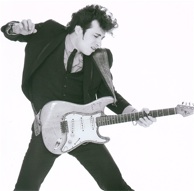
In 1951, under the sign of Capricorn,
Paul James Vigna was born.
A star athlete of the Toronto Hockey League,
young Vigna’s dad told him to
“take it easy, take your time...
hurry and worry kills the man”.
But at 12-years of age,
Paul’s heart was torn out of him
when his father suddenly passed away.
Feeling alienated by his loss,
Paul took to the isolation of his bedroom,
where the guitar became his psychiatrist,
his confidante, his brother-in-arms, and his best friend.
He immersed himself in music books,
and practice, practice, practice.
Like many young Toronto boys with guitars at the time,
Paul made his way to the coffeehouses of Yorkville
and the bars of the Yonge Street strip.
Inside these intimate clubs and booze cans of the seventies,
James furthered his education by watching
the legendary musicians who performed on their stages.
Soon Paul James was gracing the same stages fronting his own band,
Lick ‘n’ Stick.
One night when Mink DeVille
(former house band of NYC’s CBGBs),
were in town playing the El Mocambo,
Paul James was invited to their hotel to jam.
James struck up a friendship with the late Willy DeVille
and was invited to join him and his band
on a three-month tour of Europe.
Eagle Rock Entertainment captured Paul James
performing with Mink DeVille in Switzerland
in the highly regarded dvd release,
Live at Montreux (1982).
Vigna, having been Deville’d,
returned to Canada an even better musician,
and a new look.
Sporting slicked-back hair,
tight black dress pants,
colourful shirts under bolero-cut jacket,
pointed snake skin shoes,
and a diamond-studded tooth,
Paul’s band mates soon followed suit.
Well,
except for the dental work...
that was left solely to the front man.
As a result,
more and more gigs were added to
the rather good-looking band’s itinerary.
This writer may have primarily followed the Grateful Dead in the 90s,
but in the mid-80s,
she saw the Paul James Band play at least a hundred times
in places like the Albert’s Hall and Black Swan.
And in these, and other local bars and venues,
Paul James often shared the stage
with a slew of highly influential musicians.
At the El Mocambo, it was Bo Diddley.
At the Colonial Tavern, it was Lightnin’ Hopkins.
At the Horseshoe, Honeyboy Edwards,
(the same boy who played with Robert Johnson).
At the Hotel Isabella, it was Junior Wells.
At the Montreal Spectrum, John Lee Hooker.
James also played alongside Edgar Winter and
Leon Russell at the Diamond Club,
Jeff Healey at Montana’s,
and Dr. John at Toronto’s Harbourfront.
A guardian of that good ol’ rock and roll,
and keeper of the flame,
Paul James has played with the best of ‘em.
And as a disciple of the blues for over 4 decades,
he may not wish to be called a Toronto icon,
but he certainly is,
most assuredly.
And even today,
he can still duck walk all over Chuck Berry.
"It comes from working with Bo Diddley.
I don't stand still on stage," he says.
The recipient of two Toronto Music awards for
Best Club Band and Best Blues Artist,
Paul James has also been nominated multiple times
by Maple Blues.
And in 1992, he won a Juno Award for
Best Roots and Traditional Music.
Hanging onto his ideals,
and playing the music of the genre consistently,
James has never put fame ahead of it.
A musician's musician,
who’s not only made good friends with John Hammond,
but a long and extraordinary one
with the enigma otherwise known as,
Bob Dylan.
In 1986 at Toronto’s Nags Head,
James, spinning through the audience
playing guitar behind his head,
literally spun right into Robert Zimmerman himself.
With Dylan’s face suddenly inches from his own,
Paul thought he was hallucinating.
For the last set that night,
Dylan joined James on stage after
being introduced as "a hitchhiker from Vancouver”.
Since then,
James has performed with Dylan at
the Kingswood Music Theatre (Canada’s Wonderland),
the Concert Hall (Masonic Temple),
and the legendary El Mocambo.
The biggest gig he played with Dylan was in 2001
at the Air Canada Centre, in front of 20,000.
The two also played together at the Midland Arena in Buffalo, NY.
But when James played with Dylan in 2008 at
the John Labatt Centre and Centennial Hall in London ON,
and the General Motors Centre in Oshawa,
rumours spread far and wide
that Paul James would join Bob Dylan’s band, full time.
In the following interview,
Paul talks about his roots,
growing up in Toronto,
the many highlights of his career,
and yes,
Bob Dylan.
Ladies and Gentlemen...
from the streets of Toronto,
will you please give a warm welcome
to the man who rocks the blues,
the king of the strings,
the Almost Crazy...
Paul James....
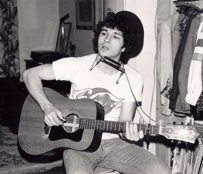
Is it true you were an accordion player first?
I was 7 and we couldn’t afford a piano, so I got a squeeze box! (laughs). But one good thing about taking accordion lessons, it helped me learn to read music. When I took up guitar, I translated one to the other.
What led you to play guitar?
When I was a kid, I was really into hockey and held the leading score in the league. It’s what got me my first write-up in the paper. Being I held the highest score of all the teams, I thought I’d be picked by the scouts; scouts who came looking for all-star players for a game at Varsity Stadium... but I wasn’t.
Why not?
I think it was because I didn’t have a dad. He had just died. I could skate circles around all those kids with dads, but it was them that got the opportunity to play at Varsity. I smashed my hockey stick, threw away my skates and quit hockey after that. I became introverted because I didn’t know anyone who had died before. I was 12 and the guitar became my escape. I played guitar day and night, giving it everything like I did hockey. With the accordion, my mom would say, “you haven’t put in your half hour yet. You have to put in at least a half hour before you can go out and play with your friends”. But with the guitar she said, “you play the same thing over and over. Please stop!” (laughs)
Where did you get the guitar?
I rented it from Netherlands Music School at Bathurst and Harbord for 50 cents a week, the same place I took the accordion lessons. I went through so many music books until eventually, I could do it myself.
Did you play music in school?
Yes, and I was at the top of my class.
What about other subjects?
My favourite subject, other than music was science. At Harbord Collegiate, there were probably fifteen Grade 9 classes. When you got your report card it would show your mark alongside the highest mark achieved in the grade for all the classes. I was always in the top three. But then I deteriorated and had to go to summer school to get through Grade 12.
What neighbourhood of Toronto did you grow up in?
Bathurst and Bloor, which at that time was mid-town Toronto; with the mid-town K Club, the mid-town bowling alley, the mid-town theatre (now the Bloor Cinema). From my house, I could hit Honest Ed’s with a stone. But at the time, the Bloor subway was being built and more room was needed. The house we lived in was in my dad’s name, and being he died, we were ordered to move. Minus the succession duty tax, we only got $17,000 for a three story house with 5 fireplaces, a driveway and a garage. We got ripped off big time. We didn’t know what succession duty tax meant.
And you moved.
My older brother moved into his own place and I stayed with my friend John, whose father was the janitor of a church down the street. I was never religious, but the church was called St. Paul’s (laughs). My mother took a room until she could find another place for us to live. There was a gym below the church, so John and I rehearsed in there. John was a drummer. When I wasn’t practicing with John, I practiced alone. No one wanted to practice as much as I did. A guy we knew, Richard Alexander, who was part-black and part-Jewish, got us gigs at bar mitzvahs.
So this was the start of your first band?
Yes, and any money we made went directly into renting speaker columns; the PA system. Sometimes we got lucky and made enough to buy Chinese food after a gig, which was a big treat. It was at this time that I started checking out the live music scene in Yorkville. It was 1964-65, and we weren’t old enough to get into bars, so John and I went to the coffeehouses. Fortunately John’s dad wasn’t only the janitor at the church, but also cleaned up the Avenue Road Ballroom. Below the Ballroom was a place called the Devil’s Den, where The Sparrow, the Mynah Birds, Jon and Lee & The Checkmates, Roy Kenner and the Associates, and Mandala played. One time during off hours, we were checking out the equipment on stage when the owner came in and said, “hey, I hear you boys are musicians... how would you like to see the show tonight?” We were like, “oh yea!” (laughs). We went back later that night and the Sparrow (later to become Steppenwolf) were playing. John Kay wasn’t in yet, but their drummer was Dennis Edmonton, the bass player was Nick St Nicholas and the lead guitarist was Jerry Edmonton. Jerry left before they became Steppenwolf, but probably made more money than any of them. Jerry wrote Born to Be Wild! (laughs) We were only 13, but that night the owner asked the band to let us sit in.
And did you?
We did! And it went over well. We played Down Home Girl... “oh I swear, the perfume that you wear, is made of turnip greens”... (Paul singing) “Every time I kiss you girl, it tastes like pork and beans...” (laughs) written by Lieber and Stoller, recorded by the Coasters, but we performed the Rolling Stones version. The other song we did was Round and Round, and what a charge to play in front of so many people. We were a big hit at school the next day. When we played the Devil’s Den again, it was with the Mynah Birds... and Neil Young was the rhythm guitar player!
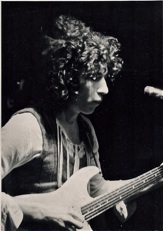
Paul James, Bermuda Tavern, 1970
Did your mother find another house?
Yes, and we moved to Clinton Street. My room was in the peak of the house. But with my dad gone, my mother continued to struggle, so one summer I went to live with my aunt in La Salle. And I took a job picking tomatoes in Leamington, Ontario.
Is this where the song Dreamington comes from?
I wrote the song much later, but yes. With the money I made I decided to buy an amplifier, one of those new Vox amps like the Beatles had. But when I told the guy in the store how much money I had to spend, he said, “oh, we don’t have anything for that price”. My mother and I were about to leave when the guy said, “we do have an old thing in the back, if you want it”. At that time, no one put much value on old amps and I ended up getting a 1940s Gibson Les Paul amplifier with four inputs and one twelve inch speaker. I think I was still short twenty bucks, but mom paid the difference. That old amp today would be a collector’s item.
Did your band have a name?
We were called Can’t Explain, after the song by The Who. The guys in the band were my hockey buddies. The goalie was the drummer. The left-winger was the guitarist. We played like it was a new sport. We took turns singing, but I ended up singing the most. Eventually I started teaching guitar, so I didn’t have to stock shelves at the grocery store.
I’d like to hear more about your folks.
My mother was French and Welsh. Her parents were homesteaders in Brittany, France and they could speak Gaelic as well as English. It would have made more sense for them to move to Quebec, but they knew someone in Saskatchewan which led them there, to where my mother was born. My grandparents went through the depression raising ten kids in the middle of Nowhere, SK. My grandfather drove wood into town on a buckboard with two oxen in the winter on roads that weren’t cleared. He had ruptures all over his body. He ended up freezing to death. One of my uncle’s went off to serve in the Second World War and my mom signed up for the Air Force too, because she wanted to find her brother. But my mom never left Canada, and my uncle was killed. My mother become a nurse, and moved to Toronto where she met my dad. My father was of Italian descent and worked as a tailor at Eaton’s. He was a lot older than my mom, and served in WW1. My father died from a blood clot that moved to his brain. The clot was caused from a gunshot he received during the war.
Were your parents’ musical?
My mom could sing and my dad liked opera, but there were no musicians in the family. One of my mom’s brothers bought a violin once, after saving his nickels and dimes, but my grandfather smashed it. He felt the money should’ve been spent on food. I’m the first musician in the family.
What set you off in music?
Seeing the Beatles on Ed Sullivan!
Of course.
What was weird about the whole British Invasion was that it was American music. In the 50s, it had reached quite a level of popularity, and then for one reason or another all the major guys started to disappear. Elvis was sent to the army, Little Richard joined the ministry, Chuck Berry got thrown in jail, and Jerry Lee Lewis created a scandal by marrying his cousin. Buddy Holly died in a plane crash and Eddie Cochrane in a car accident. It seemed all the rock and rollers were either in the ministry, the army, jail, or dead! Even disc jockey Alan Feed was indicted for payola. When Canada got the Beatles and the Stones, they were playing early rock and roll; all the great music that was being suppressed in the States. Canada got it first, and then America re-discovered their roots. It was quite a discovery for me to find Muddy Waters. There was something neat about being the only kid who had.
You’ve been quoted as saying, “the good ol' days of blues gigs in Toronto were great because bands would play for a week straight, with a matinee on Saturday”...
I started playing bars after I got out of high school. Frank Meehan placed an ad in Long and McQuade, which was on Yorkville Ave at the time, and I answered the ad. It was a three-piece band called Charlie Brown doing stuff like My Girl, Knock on Wood, I Feel Good, and Midnight Hour. The drummer had been doing most of the singing, but when I told them I could sing Hootchie Kootchie Man, they said, “You’re hired!” (laughs) We played a really rough place at Pape and Danforth called Studio 710. I got ten bucks a night and rented a room there for fifteen bucks a week, for me and my girlfriend.
Ah, so you had yourself a girl at this point...
I was starting to party and couldn’t really do that at home. And then Frank scored us a gig at the Bermuda Tavern at Yonge and Gerrard. The Bermuda Tavern was a long thin building that could have been a 3-lane bowling alley. There was a wall of mirrors on the opposite end of the room from the stage, so we had to watch ourselves play all night! (laughs). It was weird, but ended up beneficial to learning stage presence. We had the house gig at the Bermuda for about a year, playing six 40-minute sets from 7pm to 1am, 6 nights a week, with two extra sets on Saturday afternoon. At this point the band changed their name to Spring Fever. We played the blues; Muddy Waters, Howlin’ Wolf, Willie Dixon, Jimmy Reed, Elmore James, Chuck Berry, and Bo Diddley. The only white guys we covered were the Rolling Stones and Bob Dylan. I would say this was my “Beatles in Hamburg” period. Then I got a bigger apartment above a store on Spadina Ave.
What made you want to play the blues exclusively?
It was because of the Rolling Stones... there was something about their first album; being all blues. Like the Animals and the Yardbirds, I was getting blues music second hand from the Stones. And the stuff they were covering made me want to find out where they got it from. I went to Sam the Record Man on Yonge Street and headed upstairs, straight for the blues and jazz section.
What was the first album you ever bought?
It was an album by Paul Anka called 21 Golden Hits. I bought it at Woolworth’s, which at the time was at Bathurst and Bloor. I really liked the song It Doesn’t Matter Anymore, which Buddy Holly covered.
Tell me about your early experiences at the Colonial Tavern on Yonge Street.
In between sets at the Bermuda, I would run down the street to the Colonial Tavern; the blues and jazz place at the time. Rocky, the door man would say, “oh, it’s Paul James, let him in. He’ll be here for ten minutes before he has to go back to the Bermuda”. I saw Muddy Waters at the Colonial. Muddy Waters in a bar! And then I’d run back to the Bermuda and tell the Spring Fever guys, “okay we’re gonna do this one by Muddy Waters!” (laughs) The following week, I’d see Howlin’ Wolf there. I saw Big Mama Thorton there. And when I saw Buddy Guy and Junior Wells at the Colonial, they reminded me of Jagger and Richards in the sense of how they played off each other; Buddy Guy playing guitar and Junior Wells on vocal and harmonica. I saw jazz guys like Charlie Mingus and Thelonius Monk at the Colonial Tavern. It was quite the education. And I got my exercise running back and forth! (laughs)
Which of those acts stands out in your mind more than the others?
Muddy Waters! He had such control of his band. He played guitar and had two other guitar players in the band, as well as a piano player, harmonica player, bass and drums. But you could hear every instrument because the volume was kept down. I was just a young kid, but I was knocked over by the sensuality of it. The Colonial was a watering hole where people went to meet somebody and have a good time. But I liked going on the off nights, the rainy nights, when it was less populated. I just wanted to hear the music. I was a sponge sucking it all up.
And you continued to play at the Bermuda Tavern?
Yes, but Frank’s girlfriend got pregnant. She said to him, “you can come or not, but I’m going to Newfoundland.” Frank decided to follow her. At this point, I inherited the band and changed the name to Lick‘n Stick. Malcolm Glassford, who wrote for Guerrilla Newspaper saw us at the tavern one night, and wrote our first review. He said good things. We even appeared on Guerrilla Newspaper’s half-hour CityTV show. Glassford became our manager.
Tell me about working in musical theatre.
My girlfriend at the time had met a director who was doing all-original Canadian plays for Young People’s Theatre and Tim Bond, who had seen me at the Bermuda, asked me to write the music for a play. So I did! I went to work at the theatre from 9-5 every day, and played at the Bermuda from 7-1 every night!
Wow!
I wrote ten to twelve songs for each of the three musicals. One of the musicals was called Cyclone Jack about an Indian marathon runner at the turn of the century. All the vocals were done live, but the music was taped. I rehearsed with the actors and taught them how the songs went, but I was never a part of the performance. It was great getting five dollars for each show, and not having to be there! (laughs) There were two performances per day, held in schools all over Canada, and they ran for three thousand performances!
What were the other musicals you did?
The other one was Maurice which starred Fiona Reed (actress, King of Kensington). And the prop man on that one was Dan Aykroyd!
No way, really?!
Aykroyd’s job was to make sure the correct props were ready for each actor; each actor who played three different roles. When the director didn’t need us, Dan and I would go downstairs and jam. The other musical I wrote was called Finding Bumble for the Ontario Science Centre. I’d like to do another musical now; a play or movie with my own songs, based on my own life. The story you know best is your own, and most of my songs are autobiographical.
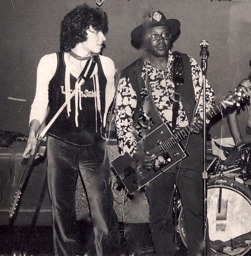
Paul with Bo Diddley, El Mocambo Toronto, 1973
What was the first big thing to happen in your career?
When I got to play with Bo Diddley in 1973 at the El Mocambo.
And how did that come about exactly?
I lived down the road from the El Mo, and when I came home from playing the Bermuda, there’d be brawls outside and guys getting handcuffed. (laughs) By the time I played there, management at the El Mo was taken over by Mike Baird. And Neill Dixon was doing the bookings, the same guy who had a folk club called Bumbles on Jarvis. Country bands were booked downstairs and upstairs were the blues acts. But when Dixon saw my band, he said, “You guys play that old rock and roll really good. Too bad you’re not from out of town.” They would only book rock and blues bands from the States. But when Bo Diddley was booked and didn’t have a band, we were asked to back him up for a whole week!
You must have been so excited!
I was determined to be the best backup band he ever had. I really practiced. And after only two songs at sound check, we got the hand signal from him to stop. (laughs) Bo Diddley said, “you guys are gonna be great!” Bo Diddley took me under his wing. But not only that, at the end of the week we recorded a movie soundtrack together. It was called Diary of a Sinner; a baby blue movie!
Get out! A baby blue movie, really?
Well, there was no cock, only tits...
No cock? Damn!
At the end of the El Mo gig, Bo said, “you didn’t make much money doing this gig, did ya?” I said, “I didn’t do it for the money. It was a real honour to play with you.” Bo said, “the El Mo wants us to come back and do two weeks. I told them I’m not doing it unless you guys back me up. Ask for more money”.
Wow!
Bo and I became really good friends, and I must have done a hundred gigs with him. I thought I’d go back to college, but ended up giving music all I had. Eventually, I also learned the music business. And just like the hockey business, it was a whole crock of shit.
Are you referring to your experience with CBS Records?
The Lick ‘n’ Stick Band was packing them in six nights a week in Peterborough, London and Ottawa. We played as good as anyone, so CBS Records signed us. But when I gave them Lazy Crazy Blues, they turned it down. “It’s a good song”, they said, “but have you heard Jive Talkin’ by the Bee Gees? Can you do something like that?”
Something tells me you didn’t want to be the next Barry Gibb.
In the States, George Thorogood was getting a shot at recording Bo Diddley songs. I was just as good as George Thorogood, so why not me? Thorogood was recording Bo Diddley songs, but I was actually playing with Bo Diddley himself! I had no intention of trying to sound like the Bee Gees, but I’d been to Jamaica and wrote a song called Mary Ann. CBS took it because it had a reggae beat, and that was the closest thing to disco they were going to get. As far as I know, Mary Ann was the first white Canadian reggae song ever!” (laughs) It didn’t get released in the States, but it did get hit-picked by Dick Clark. We were about to tour Western Canada, but disco came in so big, our tour fell apart and Lick n Stick ended. The guys went off to make airplanes and become graphic designers.
What did you do?
I bought the band out and rented a warehouse at Bathurst and King to store all the gear, lights and sound system. And I lived in the warehouse with it, while I put another band together. Gary Gray was a guitar player way back, but after renting him a keyboard, he developed into a very good piano player. Gary lived with Brian Kipping who played bass and double bass, so I got Gary and Brian in the band. But for drums, I wanted a Charlie Watts-type; a steady but simple beat with no over flash. I found Adrian Vecchiola playing drums on a rooftop beside my brother’s place, and he was perfect. I decided to manage the band as well, which was my first step toward the business side of things.
What are some memorable experiences you had playing at the Colonial?
One day I went to the Colonial for a drink in the middle of the afternoon. The owner said, “You’re Paul James”. I said, “yea”. He said, “You backed up Bo Diddley. Do you think you could do the same for Lightning Hopkins?” I was like, “ooooh, yea!” For three nights, we got to back up Lightning Hopkins! That same week, I dropped by a place called the Groaning Board; a non-smoking, vegetarian place (way ahead of its time) that served no hard liquor, but had live music. The night I dropped in, Sunnyland Slim (piano player for Muddy Waters, Sonnyboy Williamson and Howlin’ Wolf) was playing solo, but the piano was out of tune. Sunnyland, who was eighty years old at the time, had to go outside in the laneway to smoke his pipe. He wasn’t happy about that or the untuned piano, or that he couldn’t order a glass of Old Grandad bourbon. I sat in with him for a couple of tunes and then said, “if you’re gig ends early, why don’t you come over to the Colonial? They have a grand piano there that’s in tune. They got bourbon and you can smoke! (laughs) I’ll be playing with Lightning Hopkins, and maybe you can sit in with us, or get your own gig there”. Later that week, when I went up the stairs of the Colonial balcony, there’s Sunnyland Slim. I said, “Hey, you came! Do you want to sit in?” He said, “yea!” It was so f*&king great to be on stage playing with Lightning Hopkins on one side of me and Sunnyland Slim on the other! Two months later, when Sunnyland returned to Toronto, I backed him up.
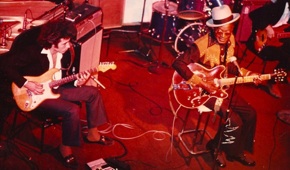
Paul with Lightning Hopkins, Colonial Tavern Toronto (1977)
Were the Colonial and the El Mo competitors?
Kind of, but the Colonial was slated to be torn down. All of Yonge Street was on its way up. My last gig there was with Ramblin Jack Elliot. It was cool playing with him; someone who knew Bob Dylan! When I was in New York, Ramblin’ Jack was playing at the Bitter End and I went to see him there. He brought me back to his dressing room while the room was cleared for the next act. Later, as we were coming out of the dressing room, the guy on stage, the next act, was Tom Waits.”
Get out!
I didn’t meet him, but I remember him at the piano in an old overcoat.
Let’s talk about the course your career took in the 80s.
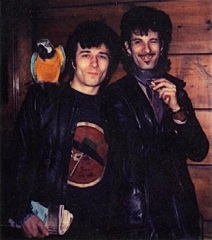
Paul with Willy DeVille,
Greenwich Village NYC, 1983
Wow!
I told the Upper Lip, “Look, I’ve been invited to join Mink DeVille”. (The Eid brothers, who owned The Upper Lip, were fans of Mink DeVille and played their stuff in between my sets). They said, “You’re joining Mink DeVille?! Alright, the big fucking time!” (laughs) I said, “But can you keep my band here? I don’t care if you get another front man, but if you keep my band working, I’ll do a few more months for you when I get back”. They agreed, and off I went with Mink DeVille.
In July 1982, Mink DeVille played to 70,000 people at an outdoor festival in Milano after Italy won the World Cup in Soccer.
Yes, we played in the street and it was all videotaped. We didn’t actually see when the squad was brought in, but there was a riot and we finished our set just before the show was shut down.
Had you ever played in front of that many people before?
Never.
Were you nervous?
You know, I wasn’t. The songs were so well arranged. And what a band, with Tommy Price on drums! (Price played on the Rebel Yell record by Billy Idol).
Was this the first time you were out of Canada?
No. I had previously hitchhiked all over Europe when I was a teen, staying at hostels. And on another occasion, I chased my girlfriend to Paris. Her parents had sent her there to separate us. I followed her and brought her back with me! (laughs) She’s since passed away, but Erica was my first love. We got together when we were 16 and stayed together until I was about 21; back when time seemed to move really slow.
Tell me about touring with Mink DeVille and the time you met the Rolling Stones.
The Stones wanted Willy to open for them in Paris, but he turned them down. Willy was bigger in Paris than anywhere. We played the Olympia, the same place the Beatles and Edith Piaf played; an old opera house the size of Massey Hall. We played three sold out nights with no opening act. And the CHUM-FM-of-Paris broadcast the show simulcast all across the city! It was when we got to Germany, Toots (Willy’s wife) said, “we’re going to see the Stones at their hotel in Hanover, ya wanna come?” (laughs) Willy and I went with Toots. There was a special key required or the elevator would bypass the floor the Stones were staying on, so Bill Wyman’s then-wife escorted us. All I kept thinking was, I’m gonna meet Keith Richards!
Keith, yes!
This was at a time when Jagger and Richards were quarrelling. So it was kind of like, either you’re in Keith’s camp or Mick’s. (laughs) I met Jagger, but got a dead hand shake. I think he was drunk. We could hear music coming out of another room, and that’s where we found Keith.
What kind of music was playing?
Keith was listening to an eclectic mix of Robert Johnson, Motown, Everly Brothers and some reggae. We started talking to Keith about working with Jack Nitzsche, but then suddenly Willy needed to score and said, “You coming Paul?” I was like oh, no! I didn’t want to leave. It was the Rolling Stones after all, and I was in their hotel room. Willy left and I stayed. I stayed until 10am the next morning!
(laughs) And what the hell were you up to all that time, huh?!
I left that morning with 15 back stage passes and fifteen tickets to the show.
You must have left one hell of an impression!
Keith really liked Mink DeVille.
And what about the other Stones? Where were they?
Charlie Watts and Bobby Keys came in and out, but Ronnie Wood sat beside me the whole time. And Ronnie’s girlfriend-wife-hair dresser was constantly doing him up. At one point, I remember being arm-in-arm singing a do-wap number with Keith and Ronnie! (laughs) And ya know, I was really happy to be able to say to Keith, “Thanks, man. Thanks for turning me on to the blues”.
Did you go to the show?
Yup, we went to the show, but we didn’t meet them again. We got the free food back stage, but the Stones weren’t there. And then we were off to the next country to do our own show. The whole European tour experience with Mink DeVille really professionalized me.
What about New York, is there something you can tell me about your time spent there?
I lived with Willy and Toots on 5th Ave, and slept on their couch. Our neighbourhood park was Greenwich Village, and I walked their dogs Domino and Hermione through Washington Square. I was within walking distance of everything in Manhattan. The local bar was the Lonestar Cafe. I rehearsed with the band and I learned the songs. It was an incredible time, and when we were recording at the Power Station, Bruce Springsteen was working in the studio next door.
Get out!
But I didn’t meet him. We were there to record Stand By Me and I played two guitar parts on it. Most of the time in NY, I was focused on learning the songs of Mink DeVille. But when we were on the road, I often wrote my own stuff on the plane or bus. The songs Rosie, The Girl I Had Before, Anna Banana and Hey Rosita were all heavily influenced by Mink DeVille. And I wrote what became my first album, Almost Crazy. I also got used to dressing up for every show. So much so, the whole look of my own band changed when I got back. The Paul James Band became slicker than any band in Toronto at that time.
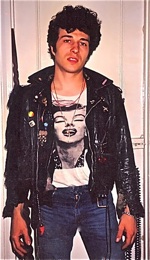
Paul in the Marilyn Monroe t-shirt, 1982
Gone were the Marilyn Monroe t-shirts?
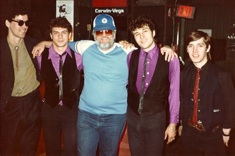
The Paul James Band in the 80s with Ronnie Hawkins, Hotel Isabella, Toronto
(Brian Kipping far left, Adrian Vecchiola, Ronnie Hawkins, Paul James, Gary Gray)
The Paul James Band released many singles and a few albums over the years.
We recorded single by single until I had enough money to release an album. When I write songs, I usually write the words first. My best songs were written in five or six minutes, typically when I didn’t have a pen. When I’m prepared with pen, paper, and glass of wine, I stare at a blank page. (laughs) Inspiration comes when it wants to. I know more guys on the other side now, so it’s weird, but I’m writing now more than ever! I’ve got stuff all over the place.
That’s great!
I ain’t done. I may never be big and famous, may never play the soft-seaters, but I ain’t done.
Rock and blues don’t suit soft-seaters anyway.
It’s not the same as playing with Bo Diddley at the El Mocambo for a week, you’re right.
I’ll take a bar over a soft-seater, any day.
I’ve made a living doing what I do. I bought my own house doing what I do. I can’t complain.
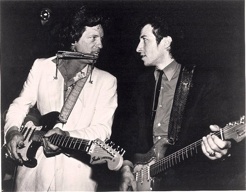
Paul with John Hammond, Edmonton, Alberta (1980s)
And you’ve played with a lot of your idols.
I played with John Hammond, who was an incredible influence on me. I backed John up at Albert’s Hall and he’s played on my records. And when I started playing acoustic solo sets, it was directly related to Hammond’s confidence in me. He said, “you do that acoustic solo thing really well”. So when I couldn’t get a gig with the band on a Monday or Tuesday, I would get gigs playing solo. It was a big part of the journey, playing solo. It made me a better writer and a better musician. And John Hammond was responsible for getting me to take that step. And where Dylan brought out the importance of Woody Guthrie, Hammond brought out the importance of Robert Johnson, Blind Willie McTell, and other guys of rural 20s, 30s and 40s blues.
When Bob Dylan showed up at your Nags Head gig (Nov 1, 1986), did he really appear only inches from your face?
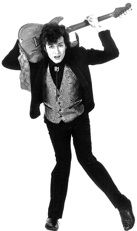
Yea! (laughs) You can see photos from that gig on my Facebook page. When I was doing my thing walking through the audience toward the bar, spinning around playing guitar behind my head, I spun right into Bob Dylan’s face! (laughs)
Oh my god.
I really thought I was hallucinating. When I made my way back to the stage to finish the half hour left in the set, I thought for sure he’d be gone by the time I was done.
Oh my god.
But I finished the set, and when I went over to the bar, Bob was still there with some girl. And he seemed very happy; laughing a lot. Every time I see Dylan, he laughs! (laughs)
After that first meeting at the Nags Head, Dylan went back to your place with you?
Yes, and we jammed all night long. I would play slide, and he’d play along with it. There was no singing, just a lot of playing. He played my black guitar. We sat on my living room floor until about ten the next morning. We smoked, we drank beer, laughed and talked.
Didn’t you also sit in with Dylan at the Concert Hall?
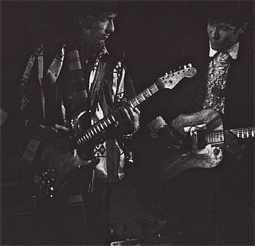
Paul with Bob Dylan
I love Leopard Skin Pillbox Hat! Tell me more about the gigs you’ve done with Dylan.
One time before an El Mo gig, I was supposed to pick Bob up. And I got lost! (laughs)
You got lost in Toronto?
I didn’t make my turn. I was excited, and went too far! (laughs) Realizing I’d be late for my own gig, I blew him off and headed straight for the El Mo! (laughs)
Oh my god.
But as soon as I walked through the doors of the El Mo, there’s Bob! He was already there and had his daughter Anna with him. After the show, he came back to the dressing room and we passed my acoustic back and forth. He asked about my songs, and when I told him for every 20 that I write, there’s only one I keep, Bob says, “that sounds about right”. I thought to myself, but he’s written so many f&%king songs! (laughs) I wondered about all the songs he threw away!
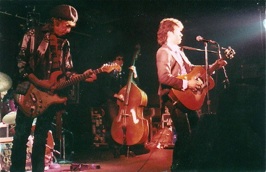
Paul with Bob Dylan, 1986
I can’t believe how much you look like Dylan, Paul. And you’re looking like him more every day; the young Dylan that is. So I guess you’re growing younger!
You know, I could never have a Beatle haircut. My hair just wouldn’t work that way. When Dylan came along, I thought yea, I can do that! (laughs) And then Willy got me slickin’ it up.
Tell me a story about Dylan and Copps Coliseum.
I parked my van right in front of Dylan’s bus at Copps Coliseum, like I was told. And then these guys came and took me to my seat. I was then told, “Right after the encore, we’ll come back and bring you to Bob. He wants to talk to you.” When I was taken to see Bob, the first thing he says to me is, “hey, I saw that video where you played with Mink DeVille. Willy is something else.” (Willy was still alive at this point). We talked about Mink DeVille and then Dylan said, “you think you could play guitar for me?” I said, “yea!” (laughs) “You’d be playing lead guitar, not rhythm”. I said, “cool!” I immediately set out to learn all his stuff, but Bob doesn’t do anything the same as he has before. He changes the arrangement of his songs every time he plays them! It was impossible to learn the songs this way, but I tried to be as prepared as possible.
It was 2008 when the rumours began you would be joining Dylan’s band.
Yes, when the Canadian tour brought him to London and Oshawa. The night before one of the shows, his manager called and said, “If you’re coming to the show, Bob wants you to bring your guitar”. I said, “oh, what does he have in mind?” His manager said, “he’s gonna pull his two guitar players off and have you do the first five songs, both nights”. I’m like, “oh! Do you know what songs he’s going to do?” His manager said, “you’ll find out when you get there!” (laughs)
Oh my god.
So I get there and meet the guys and then we waited; waited for the set list to come down (laughs). Bob decides what he wants to do at the very last minute.
I’m a nervous wreck just listening to this.
(laughs) The set list comes down and we’re trying to figure out the keys. If you’re a guitar player, you play in G, E, A and C, but in the set list, Dylan’s got C sharp, A flat, E flat, G flat. It was all flat keys, none of which he recorded the original songs in! (laughs) Dylan was playing strictly keyboards on this tour. We did a couple bars of each tune, and then the curtain went up, and away we went!
Oh my god. I need a drink.
The next night, same thing; we waited to the last minute for the next five songs.
Did you get the call to join his band?
After those shows, his manager said to me, “Bob was really happy with the show. Don’t tell the other guys, but it looks like you got the gig”. I had my bags packed and ready to go. But at the last minute, I got the call that said, “can’t do it.” Charlie Sexton, Bob’s guitar player and who I believe is Bob’s godson, really wanted to play in the band again. I don’t know exactly what happened, but I think it was probably easier for Bob to just give the spot to Charlie than to get me out of Canada. It wasn’t meant to be. But I came that f&%king close!
Dylan could call you again tomorrow, couldn’t he?
I have only good things to say about Bob. He reached back to me; someone with no agent, no manager, no record company, no nothing. He could call me again tomorrow, yes, because that’s what he does.
I’d be taking anxiety pills, if I were you.
(laughs) Right up till that tour ended, I still wasn’t sure. John Hammond called and left a message saying, “the word on the street is you got the gig with Bob”.
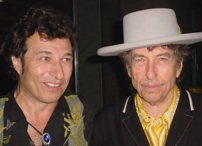
When Dylan was playing the O’Keefe Centre, I had played a benefit show earlier in the day. When I got home afterwards, there was a message on my answering machine saying a ticket was waiting for me at the door. I tore down there, parked, but when I got to will call, I was told, “nope”. I’m like, “really, are you sure? I got a message from a very reliable source that there was something here for me.” But no. I started wandering back to where my van is parked when someone runs up to me saying, “hey, you Paul James?” I said, “yea!” Before I knew it, I was ushered in to the show on time for the encore, and Ronnie Hawkins is on stage with Dylan. After the show, I tried to get back stage. There was a glass door and I could see Ronnie on the other side. I yell out, “Hey Ronnie!” Ronnie sees me and says, “hey, let him in, that’s Paul James!” But Bob had already left.
Bob Left the Building?
Bob had left the stage and got right on the bus.
Bob Left the Building on a Bus?
I was heading to my van when this girl comes up and asks, “are you Paul James?” I said, “yea!” She says, “do you want to see Bob?” I said, “yea!” She says, “follow me in your van”. I follow her and we go all the way to the Inn on the Park, where there’s a huge parking lot. Way in the back, under a tree is a bus. I pull my van up alongside it, and when I get out, Bob’s there, laughing! (laughs)
Oh my god.
Bob says, “did you bring a guitar?” I said, “yea!” Bob says, “I’ll call and get some chairs brought out. I want to hear you play Hot Tomales and they’re red hot!” (laughs) In the parking lot of the Inn on the Park!
What are some of the songs you’ve played with Dylan on stage?
When the Levee’s Gonna Break, Like a Rolling Stone, Hwy 61, Wicked Messenger, Tom Thumb’s Blues, Not Fade Away, Cats in the Well, and others. I’ve played Stuck Inside a Mobile, with him, in A flat! And he gave me three solos! (laughs) There isn’t even a solo in the song! (laughs!) We’ve done Tangled Up in Blue together, but nothing like the way it was recorded. And I had to start it off!
Are there certain Dylan songs that you haven’t done with him, but would like to?
I’ve played with Bob a lot, and would enjoy playing more; more blues-oriented stuff. I really like hanging out with him. He’s a writer and a band leader. I’m a writer and a band leader. Bo Diddley was a writer and a band leader. Willy deVille was a writer and band leader. I’m not a side man, but I’m a side man to them. They’re older and they’re better. Through them, I’ve become a better writer and band leader.
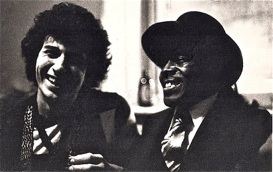
Paul with Junior Wells, Hotel Isabella Toronto (1970s)
Let’s talk about some of the other musicians you’ve played with; Junior Wells for instance.
When I started playing bars I wasn’t even old enough to be in bars, but there was a certain sexuality in what Wells was doing when I saw him at the Colonial. I wanted that sexuality in my songs. At the end of the 70s, when I was playing downstairs at the Lower East Side, Junior Wells was playing upstairs. At one point, Wells came down and sat in with my band. Afterward, we hung out and talked music. He told me, “Stomp with your left foot. That’s a direct line to your heart”. Every time I stomped with my left foot after that, I would think of Junior Wells. (laughs) I also liked how he got dressed up in those big colourful hats.
And John Lee Hooker?
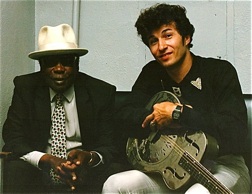
Paul with John Lee Hooker, Montreal Spectrum (1990s)
Sweet Little Angel is one of my favourites that you do. “I love the way she spreads her wings...” Now that’s sexy! Who wrote that song originally?
I originally heard it as Sweet Black Angel by Robert Nighthawk. But when B.B. King covered it, he substituted Black for Little... I’m not really sure who wrote it.
What version of the song turned you on to it?
I got it from the Buddy Guy album, A Man and the Blues. And when I recorded Sweet Little Angel in 1986, I added horns to my version. Bo Diddley did the liner notes on the recording, which was really cool.
I recently read some stuff about Chuck Berry’s sexuality. Apparently he has some very strange preferences. Tell me about Chuck Berry’s musical influence over you.
Chuck Berry’s guitar playing influenced me tremendously. I recorded some of Berry’s songs; Nadine and Oh Carol. He was another one I found through listening to the Stones and the Animals. And Chuck Berry led me to his influences, T-Bone Walker, Louis Jordon and Charlie Christian.
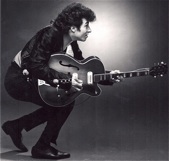
T-Bone Walker and Charlie Patton played guitar behind their backs, and Jimi Hendrix did the same. I wanted to do everything I could to be entertaining, so I started doing it. People seemed to like me playing guitar behind my back and when I got a wireless in the eighties, it gave me a lot more freedom to wander over to the bar playing behind my back. And I could spin around and play. When people go see Chuck Berry, they expect to see the duck walk. Jimi Hendrix was expected to set his guitar on fire and The Who were expected to kick over their drums, blow up their amps and smash all their equipment. I didn’t invent playing behind my head, but I believe I coined spinning around while playing behind my head.
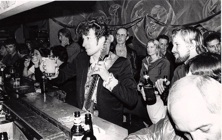
Paul plays guitar while ordering a drink at the bar
Your birthday is at the end of the week and you’ll be turning 60! What a great career you’ve had, and continue to have! Do you know you share your birthday with David Ruffin of the Temptations?
I do? No way! David Ruffin’s my favourite of the Temptations. I may have to do My Girl at my birthday show! (laughs)
What was the best advice you ever got and who gave it to you?
Bo Diddley told me, “don’t sign anything”. (laughs) Bo taught me not to be afraid and to be independent. When I put out my own 45s, EPs, and LPs, Bo Diddley was right there saying, “That’s what to do. Don’t you be getting down on your knees to beg for a recording contract, do it yourself!” Being my own manager was tough, and I had to fight off a lot of stuff. I’ve worked really hard, but it’s been a labour of love. I know it’s not the big time, but I’m grateful to be able to do what I do. I’m very fortunate that other musicians and the guys in my band have wanted to play with me for the last forty plus years. My story is of a guy from Toronto who’s made a living doing what he loves. That’s my accomplishment.
If you’re looking to satisfy your soul with that good ol’ rock and roll, Paul James will be celebrating his 60th birthday on Friday, January 14, 2011 at Toronto’s Sound Academy. Be there!
Paul James has also just completed songs for the new documentary, The Church
of Elvis, airing on Vision TV on Mon, Jan 10, Tues Jan 11, & Wed Jan 12
(10pm ET/7pm PT).
For further info, see the Vision TV website...
http://www.visiontv.ca/Programs/documentaries_churchelvis.html
~ all photos courtesy of Paul James Band Inc.
Paul James Band official website
Paul spinning/playing behind his head with Danny Marks and Jack DeKeyzer
http://www.youtube.com/user/pauljamesband#p/u/22/D1cn_7PlWZM
Mink Deville
Live at Montreux 1982 dvd
http://www.eagle-rock.com/product/EREDV684/Live+at+Montreux+1982
Sound Academy
http://www.sound-academy.com/inside/
___________________________________


INFO & LISTINGS BY: VENUE BLUES (TBS) ROCKABILLY 905 MISS. AREA STT FAVOURITES


